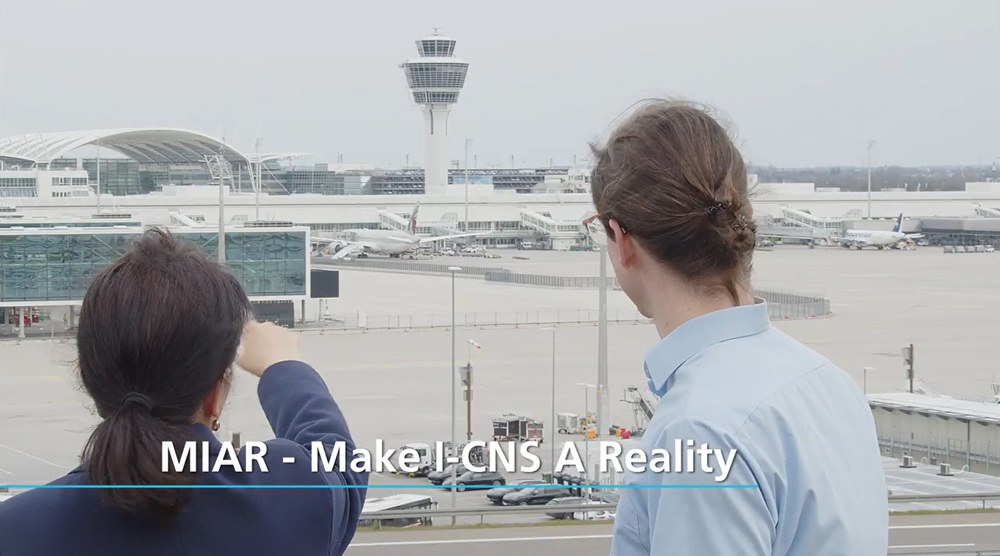MIAR - Make I-CNS A Reality
In this context, the MIAR (Make I-CNS A Reality) project, founded by the SESAR3 Joint Undertaking, focuses on the use of the capabilities of the L-band digital aeronautical communication system (LDACS) in terms of safety, efficiency and resilience. In flight test campaigns, MIAR will demonstrate several complementary navigation technologies such as e-DME, terrain-based navigation and radar-based navigation as well as the navigation function in LDACS. In the area of communication and surveillance, the project will validate air-to-ground SWIM (System-Wide Information Management) solutions.
The work in MIAR to develop further the LDACS technology will be instantly scalable to all airspace that will be supported by LDACS. Initially, LDACS is targeted at the SES area, but due to the nature of the technology on the ground and the simplified integration into existing avionics equipment, the technology is fully capable of scaling up and supporting global operations. LDACS will also be a critical underpinning infrastructure supporting i4D, and Full 4D operations in the European region, and able to rapidly expand to other high traffic areas of the globe. As the target terrestrial air-ground communications infrastructure for SES airspace LDACS will carry all trajectory and related flight data downlinks, as well as ground-initiated controller communications. MIAR will ensure that the LDACS technology is fully interoperable with evolving SWIM specifications, primarily the so called ‚purple profile’ which is tasked with securely carrying all exchanged safety-critical air-ground communications, including supporting i4D. This extends to supporting trajectory data which must be delivered with high accuracy and integrity in order to support key operations such as departure and arrival management systems, including runway occupancy optimization functions which will also be validated as part of MIAR. The delivery of appropriately safe and secure flight derived information into such ground airspace optimization tools will generate significant and on-going safety and environmental benefits, including reduction in taxiing and holding times within airport and approach operations.
MIAR will further aim to demonstrate the capabilities and related benefits of the development work as part of organized flight trial activities where possible and thus reach TRL 6 for the demonstrated technologies. This will allow for validation in close to real world airspace environments, and so will contribute to the refinement of operational and technical requirements which will be introduced into the appropriate standardization forums such as at ICAO.
A further part of MIAR which will maximize the impact of the work is to also include a Cost Benefit analysis for the improved LDACS technology as a whole. The benefits discussed above will undergo detailed estimation and will be thoroughly evaluated along with the forecast costs for the technical improvements described. This is critical to ensure that the business case for deploying the LDACS infrastructure in the real world remains robust and positive for stakeholders in support for the acceleration for the adoption of LDACS and the operational capabilities that will be thus enabled.

Video: MIAR - Make I-CNS A Reality
Your consent to the storage of data ('cookies') is required for the playback of this video on Youtube.com. You can view and change your current data storage settings at any time under privacy.

SESAR
Project duration: 06/2023 bis 05/2026
Partner:
- DLR – Institut für Kommunikation und Navigation
- DLR – Flugexperimente
- CIRA – Centro Italiano Ricerche Aerospaziali SCPA
- Eurocontrol – European Organisation for the safety of air navigation
- Rhode&Schwarz GmbH &Co. KG
- ENAIRE
- Frequentis AG
- Frequentis Romania SRL
- Honeywell International SRO
- General Electric Deutschland Holding GmbH
- INDRA Sistemas SA
- LEONARDO – Societa per Azioni
- THALES Italia SPA
- ZHAW – Züricher Hochschule für angewandte Wissenschaften
- NATS (EN Route) puplic limited company
Funded by: SESAR JOINT UNDERTAKING 3

EU

SESAR

